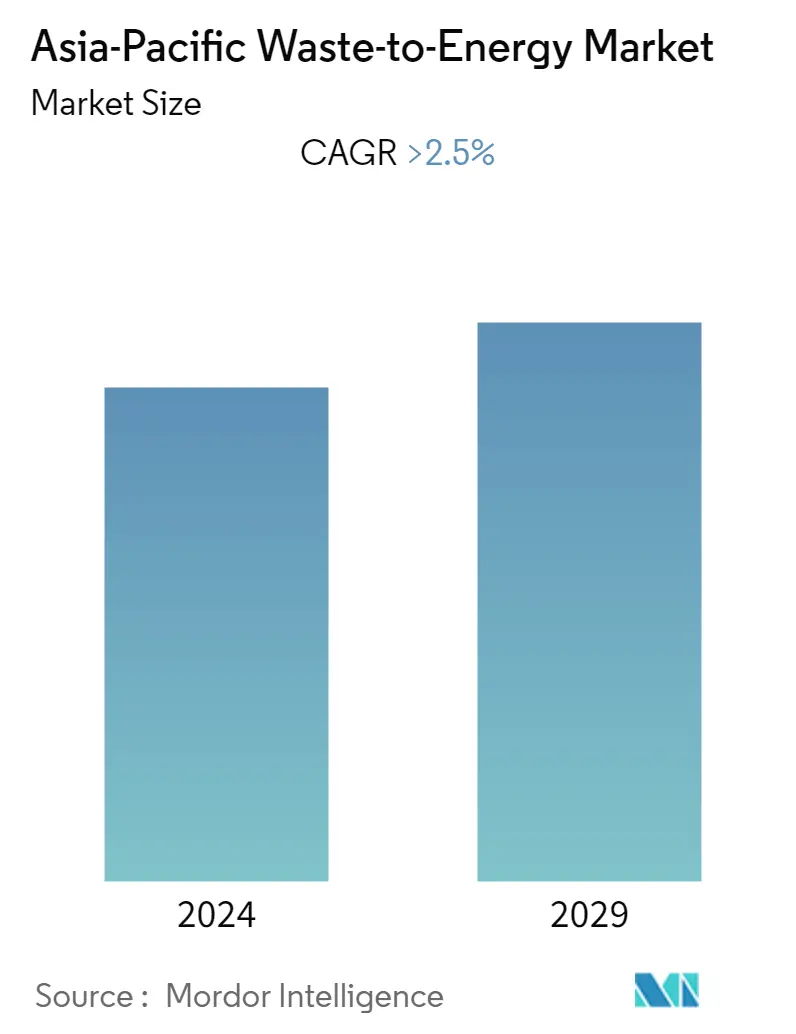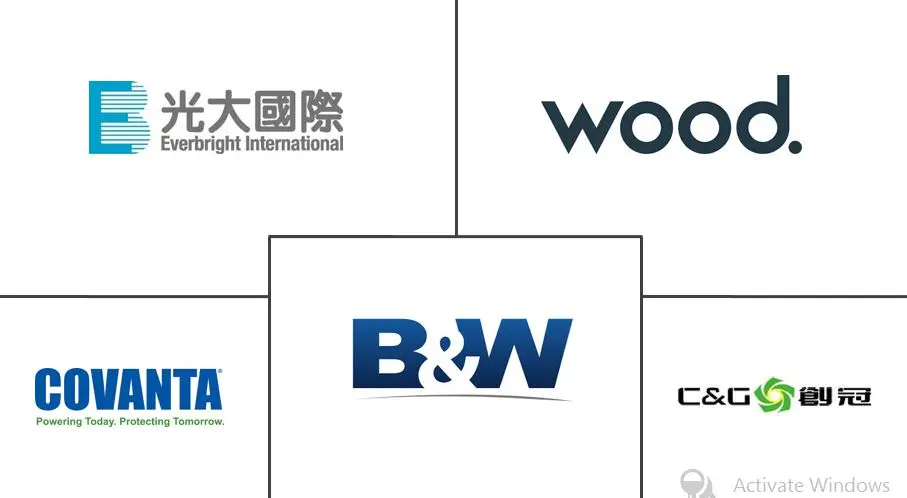Market Size of Asia-Pacific Waste-to-Energy Industry

| Study Period | 2020 - 2029 |
| Base Year For Estimation | 2023 |
| Forecast Data Period | 2024 - 2029 |
| Historical Data Period | 2020 - 2022 |
| CAGR | > 2.50 % |
| Market Concentration | Low |
Major Players
*Disclaimer: Major Players sorted in no particular order |
APAC Waste-to-Energy Market Analysis
Asia-Pacific waste-to-energy market is expected to grow at a CAGR of greater than 2.5% during the forecast period. With the increasing rate of municipal waste generation, the countries around the region are giving emphasis on reducing the waste by utilizing it to generate energy in the form of methane. Using the municipal waste to generate substantial energy in the form of heat and electricity can help to stabilize the increasing carbon footprint, that are getting generated by burning various fossil fuels such as coal and natural gas to produce energy. Organic waste, a form of municipal waste, is the largest form of waste that is mostly getting generated from the developing nations in the region, accounts nearly 53% of the total waste generates annually in the region. Waste to Energy (WtE) implies a set of technologies that treat municipal waste to extract energy in the form of heat and electricity. Uses of the technologies also help to obtain biogas as an alternate form of fuel. The drivers of the market are the increasing dumping and open burning of wastes that directly or indirectly impact human health and the environment. However, WtE plants produce ash that needs to be disposed of safely, usually in landfills that are lined with barriers to prevent ground water contamination.
- Incineration is one of the prominent waste to energy technology. During the year 2018, the technology nearly covered almost 40% of the total waste to energy installations in the region.
- Waste generation is overgrowing in the region with the increasing population. By 2050, Asia-Pacific is expected to have around 1.3 billion tonnes of waste. Moreover, daily per capita waste generation in the region is expected to get increase by nearly 40% by 2050. Thus, increasing municipal waste volume and increasing demand for energy in the region is expected to create an opportunity for the waste-to-energy market in the near future.
- China is one of the prominent countries in the WtE market, with Shanghai as the major city that process the highest waste to generate energy for heat and electricity purpose. The country produces an annual amount of over 220 million tons of municipal waste per year.
APAC Waste-to-Energy Industry Segmentation
The Asia-Pacific waste-to-energy market report include:
| Technology | |
| Landfill Gas Collection | |
| Incineration | |
| Co-Processing | |
| Pyrolysis/Gasification | |
| Anaerobic Digestion |
| Geography | |
| China | |
| Japan | |
| Australia | |
| Rest of Asia-Pacific |
Asia-Pacific Waste-to-Energy Market Size Summary
The Asia-Pacific waste-to-energy market is poised for significant growth, driven by the increasing generation of municipal waste and the rising demand for energy in the region. This market leverages technologies that convert waste into energy, primarily in the form of heat and electricity, helping to mitigate the environmental impact of fossil fuel consumption. Organic waste, a substantial component of municipal waste, is predominantly produced by developing nations in the region. The market is further propelled by the need to address the health and environmental issues associated with waste dumping and open burning. Incineration stands out as a key technology within this sector, with a substantial number of plants operational across the region, particularly in China, which is a leader in waste-to-energy initiatives.
China plays a pivotal role in the Asia-Pacific waste-to-energy market, with significant investments in incineration plants and waste sorting initiatives. The country's strategy to manage its burgeoning waste production includes expanding its incineration capacity and enhancing recycling efforts in major cities. This expansion is part of a broader plan to reduce pollution and optimize waste management. The market is characterized by a fragmented landscape with several key players, including Wood Group Plc, Babcock & Wilcox Enterprises Inc., and Everbright International Ltd., among others. These companies are instrumental in advancing waste-to-energy technologies and infrastructure, supporting the region's transition towards more sustainable energy solutions.
Asia-Pacific Waste-to-Energy Market Size - Table of Contents
-
1. MARKET OVERVIEW
-
1.1 Introduction
-
1.2 Asia-Pacific Waste-to-Energy Market in GW, till 2025
-
1.3 Recent Trends and Developments
-
1.4 Government Policies and Regulations
-
1.5 Market Dynamics
-
1.5.1 Drivers
-
1.5.2 Restraints
-
-
1.6 Supply Chain Analysis
-
1.7 Porter's Five Forces Analysis
-
1.7.1 Bargaining Power of Suppliers
-
1.7.2 Bargaining Power of Consumers
-
1.7.3 Threat of New Entrants
-
1.7.4 Threat of Substitute Products and Services
-
1.7.5 Intensity of Competitive Rivalry
-
-
-
2. MARKET SEGMENTATION
-
2.1 Technology
-
2.1.1 Landfill Gas Collection
-
2.1.2 Incineration
-
2.1.3 Co-Processing
-
2.1.4 Pyrolysis/Gasification
-
2.1.5 Anaerobic Digestion
-
-
2.2 Geography
-
2.2.1 China
-
2.2.2 Japan
-
2.2.3 Australia
-
2.2.4 Rest of Asia-Pacific
-
-
Asia-Pacific Waste-to-Energy Market Size FAQs
What is the current Asia-Pacific Waste-to-Energy Market size?
The Asia-Pacific Waste-to-Energy Market is projected to register a CAGR of greater than 2.5% during the forecast period (2024-2029)
Who are the key players in Asia-Pacific Waste-to-Energy Market?
Wood Group Plc , Babcock & Wilcox Enterprises Inc. , C&G Environmental Protection Holdings Ltd , Everbright International Ltd. and Covanta Holding Corporation are the major companies operating in the Asia-Pacific Waste-to-Energy Market.

